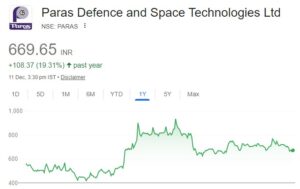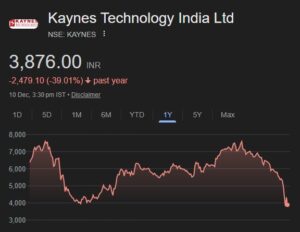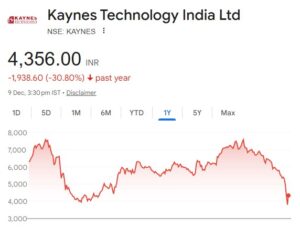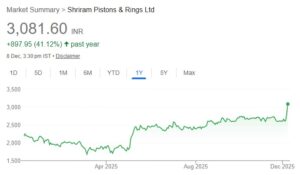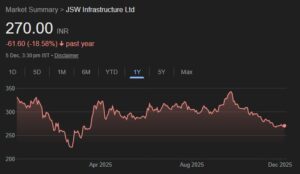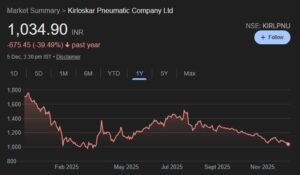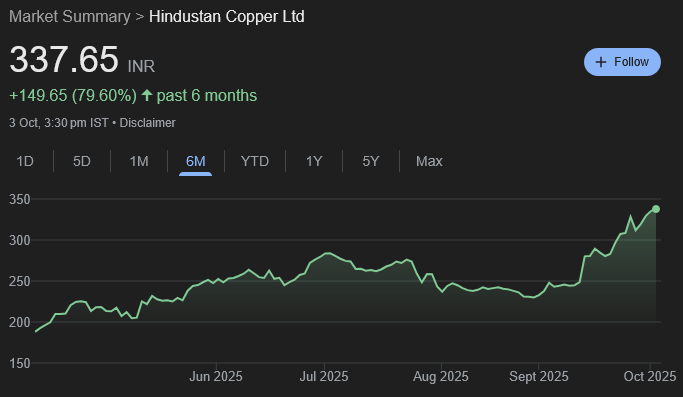
Copper prices are on a tear again, trading above $10,000 per tonne, as a series of supply disruptions tighten global availability of the industrial metal. From mine accidents to social unrest across major producing countries, the supply side has become the key driver of the rally.
In contrast to earlier commodity upcycles led by robust demand, particularly from China, this one is being fuelled by scarcity. And Indian investors are riding the wave. Shares of Hindustan Copper Ltd (HCL), the country’s sole vertically integrated copper producer, have surged nearly 79% in the past six months, outpacing both global peers and benchmark indices.
Global Disruptions Fuel the Rally
This year’s list of supply setbacks is unusually long. Flooding at Congo’s Kamoa-Kakula mine in May, an accident at Chile’s El Teniente mine in July, and social unrest affecting Peru’s Constancia mine earlier this month have all dented output. But the most severe blow came from Indonesia, where a deadly accident at Grasberg, the world’s second-largest copper mine, has halted production. Grasberg alone contributes around 4% of global supply and is unlikely to return to normal operations before 2027.
With such major sources offline, analysts believe copper prices may need to rise further, potentially to $12,000 per tonne, to balance demand.
A Supply-Driven Rally, Not a Classic Bull Market
Commodity cycles tend to fall into two categories: demand-driven “good” bull markets, which are sustained and investment-friendly, and supply-driven “bad” ones, which often fade quickly once production normalises. The current copper surge clearly falls into the latter camp.
While hedge fund managers such as Pierre Andurand have floated ultra-bullish forecasts, even suggesting $40,000 copper by 2030, most analysts remain cautious. Prices are up primarily because of lost output, not booming consumption.
China’s Tepid Demand Keeps a Lid on Optimism
For a multi-year bull market to take hold, copper needs strong demand growth from China, which accounts for half of global copper consumption. But that engine is currently sputtering. The Chinese real estate sector remains weak, exports are under pressure amid trade tensions with the US, and local premiums, a key indicator of demand health, have slipped below their five-year average.
That makes the current rally look more like a supply squeeze than the start of a long-term structural uptrend.
Hindustan Copper: India’s Pure Play Beneficiary
Against this backdrop, Hindustan Copper has emerged as one of the biggest domestic beneficiaries. With no major private-sector mining competition, HCL’s performance is tightly correlated to global copper prices. The company has been expanding capacity at its Malanjkhand, Khetri, and Surda mines, aiming to ramp up production as prices stay elevated.
Investors have rewarded that positioning. The stock has nearly doubled from its April levels, reflecting optimism that sustained high prices could sharply improve profitability and revive India’s copper self-sufficiency.
Analysts note that even a modest increase in HCL’s refined copper output could significantly boost margins at current price levels. Moreover, India’s ongoing energy transition — from EVs to renewable grid infrastructure — offers a long-term demand cushion for domestic copper producers.
The Road Ahead
While the global copper market remains in deficit for now, fresh supplies could return as early as next year. The potential reopening of Panama’s Cobre Panama mine, which alone accounts for 1.5% of global supply, could ease some pressure. New projects in Chile, Mongolia, and the Democratic Republic of Congo are also expected to come online by 2026.
That could cap further price gains unless demand from China and India accelerates meaningfully.
For investors, Hindustan Copper offers a pure-play exposure to this complex mix of supply disruptions and long-term electrification demand. The red metal may remain hot for now, but the real test for both copper and HCL will come when the market shifts from scarcity to growth.
